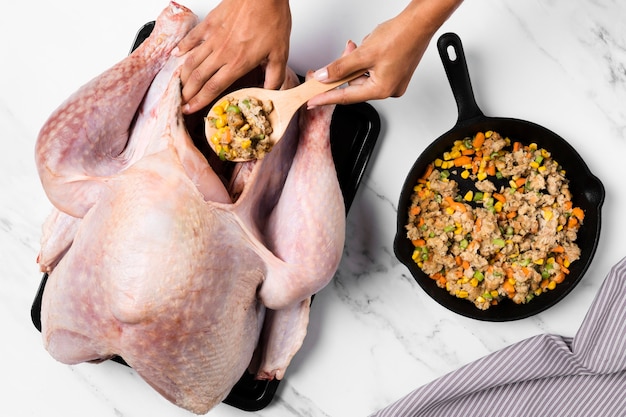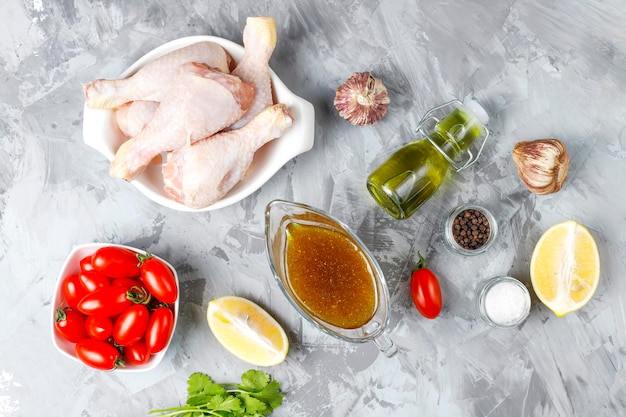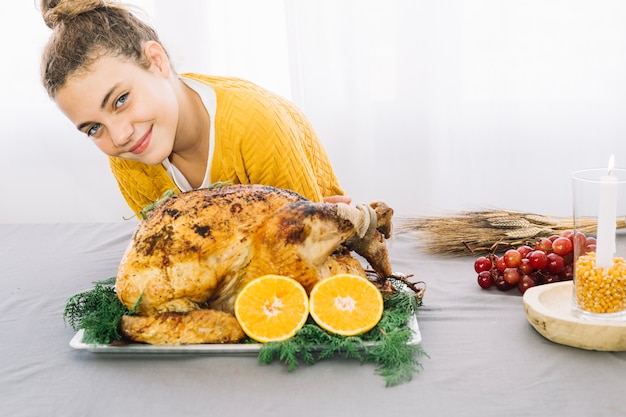We've all been there, right? It's 6 pm, you're starving, and the last thing you want to do is spend an hour slaving over a hot stove. That's where frozen chicken comes in handy. It's a pantry staple, a lifesaver when you need a quick and easy meal on the table. But, let's be honest, getting it cooked perfectly can be a bit of a challenge. You don't want to end up with dry, rubbery chicken, do you? No way! So, I'm going to share my foolproof guide to cooking frozen chicken. It's been tested and tried in my kitchen countless times, and I can promise you, it works wonders.
Part 1: Getting Ready for Cooking

1. The Right Tools for the Job: Choosing Your Pot or Pan
Before you even think about thawing, let's talk about the right cookware. You want something that'll distribute heat evenly, preventing your chicken from getting burnt on the outside and raw in the middle. A trusty cast iron skillet is my personal favourite for most things, but a heavy-bottomed stainless steel pan or a good quality non-stick pan will also do the trick. The key is to have a pan that can withstand the heat and handle the weight of the chicken.
2. Thaw It Out: No More "Straight from the Freezer" Cooking
This is crucial. Just chucking frozen chicken into the pan is a recipe for disaster. Give it a chance to thaw out properly! You have two main options:
- The Overnight Method: Pop it in the fridge overnight. It's the most gentle and ensures the chicken thaws evenly. It's my go-to, especially if I have time.
- The Speedy Defrost: Submerge your chicken in a bowl of cold water. Remember, it's cold water, not warm! Change the water every 30 minutes or so to maintain the temperature. This method works for a pinch, but don't let it sit in the water for more than an hour.
One important note: Never, ever thaw chicken at room temperature. It can become a breeding ground for bacteria, which is a big no-no for food safety.
3. Wash Up Time: Hygiene First!
Food safety is always paramount. Before you touch that chicken, give your hands a good scrub with soap and water. Then, disinfect your work surfaces. I always use hot soapy water and a clean cloth to wipe down everything. Finally, rinse the chicken under cold water. Don't forget to pat it dry with kitchen paper. You want the chicken to brown nicely, not steam in its own juices!
Part 2: Cooking Methods: From Oven to Stovetop

Here's where the fun begins. There are several ways to cook frozen chicken, and each has its advantages:
1. The Classic Choice: Roasting
Roasting is a classic for a reason. It's simple, foolproof, and delivers perfectly juicy chicken. You can roast a whole chicken, breasts, thighs, or even drumsticks.
Here's how I do it:
- Preheat your oven to 180°C (350°F).
- Line a baking tray with baking paper.
- Place your chicken on the tray and season generously with salt and pepper. I love to add a touch of paprika, rosemary, and garlic.
- For an extra-flavorful meal, toss in some veggies like carrots, potatoes, and onions to roast alongside the chicken.
- Roast for about 45-60 minutes for a whole chicken, or 20-30 minutes for individual pieces, depending on size.
- The chicken is done when it's golden brown, the juices run clear when you pierce it with a skewer, and the internal temperature reaches 74°C (165°F).
2. The Speedy Solution: Pan-Frying
If you're in a hurry, pan-frying is your best bet. It's quick and delivers delicious results, but it does require a bit more attention.
- Heat a drizzle of oil in your chosen pan over a medium heat.
- Add the chicken pieces and cook for about 5-7 minutes on each side, or until they are golden brown and cooked through.
- For an extra boost of flavor, you can add a knob of butter to the pan once the chicken is nearly cooked.
- Season generously with salt, pepper, and your favorite herbs and spices.
3. The Creamy Comfort: Chicken Casserole
Chicken casserole is the ultimate comfort food. You can use leftover roasted chicken or cook some fresh pieces.
- Place the chicken in a casserole dish.
- Add your favorite vegetables, such as carrots, peas, potatoes, or even a mix of colorful bell peppers.
- Create a creamy sauce using milk, flour, and cheese. You can also add herbs and spices like parsley, thyme, and a pinch of nutmeg.
- Season with salt, pepper, and any other spices you like.
- Cover the dish and bake in a preheated oven at 180°C (350°F) for 30-40 minutes, or until the chicken is cooked through and the sauce is bubbling.
4. The Flavorful Choice: Chicken Stir-Fry
Want to make a quick and delicious weeknight meal? Chicken stir-fry is a great option. It's perfect for using up leftover roasted or pan-fried chicken.
- Heat your favorite oil in a wok or large frying pan.
- Add your chopped chicken and stir-fry until cooked.
- Toss in your choice of vegetables, such as broccoli, carrots, bell peppers, onions, and mushrooms.
- Season with soy sauce, ginger, garlic, and a touch of chili flakes for a kick.
- Serve over rice or noodles.
Part 3: Temperature Check: Ensuring Your Chicken is Cooked Through

This is the crucial part. You don't want to take any chances with undercooked chicken. The best way to ensure your chicken is cooked through is to use a meat thermometer. It's the most accurate way to check the internal temperature.
Here's how to do it:
- Insert the thermometer into the thickest part of the chicken, making sure it doesn't touch any bone.
- Wait for the reading to stabilize.
- You're looking for an internal temperature of 74°C (165°F).
If you don't have a meat thermometer, there are a few visual cues to look for:
- The chicken should be cooked through, with no pink showing.
- The juices should run clear when you pierce the chicken with a fork.
Part 4: Rest Time: Let It Relax and Rehydrate
Once your chicken is cooked, give it a chance to rest. Let it sit for 5-10 minutes before you carve or serve it. This allows the juices to redistribute, resulting in more flavorful and tender chicken. It's like a little spa day for your chicken!
Part 5: The Finishing Touches: Sauces, Sides, and Extra Flavor
You've cooked your chicken perfectly, now it's time to take it to the next level. Let's talk sauces, sides, and ways to add that extra touch of deliciousness.
1. Sauce-tastic: Elevate Your Meal
A good sauce can make or break a meal. There are endless possibilities when it comes to chicken sauces. Here are a few ideas:
- Creamy Gravy: Classic and comforting, perfect with roast chicken.
- Tangy Lemon Sauce: A refreshing and bright option for grilled chicken.
- Spicy Chili Sauce: Add a kick to any chicken dish with a homemade or store-bought chili sauce.
- Honey-Soy Glaze: A sweet and savory option for pan-fried chicken.
2. Sides That Shine: Complementary Flavors
The best side dishes for chicken are those that complement the flavor and provide a balance. Here are a few favorites:
- roast potatoes: Crispy on the outside, fluffy on the inside, and a classic pairing for roasted chicken.
- mashed potatoes: Creamy and comforting, a perfect side for any type of chicken.
- fluffy rice: A light and versatile side for stir-fries or casseroles.
- Green Salad: A refreshing and healthy addition to any chicken meal.
- Steamed Vegetables: A simple and healthy option for a balanced meal.
3. Extra Flavor Boost: Don't Forget the Herbs and Spices
Don't be afraid to experiment with different herbs and spices to enhance the flavor of your chicken. Here are a few that pair well:
- Rosemary: A classic choice for roast chicken.
- Thyme: Adds a subtle, earthy flavor to any type of chicken.
- Garlic: A must-have for any chicken dish.
- Paprika: Gives a smoky flavor to roasted or pan-fried chicken.
- Ginger: A great addition to stir-fries or Asian-inspired dishes.
Part 6: Leftovers? Not a Problem! Get Creative
Leftover chicken? Don't even think about throwing it away! It's a blank canvas for delicious meal ideas. Here are a few ideas to inspire you:
- chicken salad Sandwiches: Combine shredded chicken with mayonnaise, celery, onion, and your favorite herbs and spices.
- Chicken Wraps: Fill tortillas with shredded chicken, your favorite veggies, and a dollop of salsa or guacamole.
- Chicken Soup: Use leftover chicken to create a hearty and comforting soup with vegetables and broth.
- Chicken Curry: Leftover chicken is perfect for a flavorful and aromatic curry.
- Chicken Pizza: Top your favorite pizza crust with chicken, cheese, and your choice of toppings.
Part 7: Frozen Chicken: Do's and Don'ts
Here's a quick guide to ensure you're cooking frozen chicken safely and effectively:
| Do | Don't |
|---|---|
| Thaw chicken properly in the fridge or in cold water | Thaw chicken at room temperature |
| Wash your hands and surfaces thoroughly before handling chicken | Touch raw chicken with your hands before washing them |
| Cook chicken to an internal temperature of 74°C (165°F) | Undercook chicken, as it can be dangerous |
| Let cooked chicken rest for 5-10 minutes before carving | Carve chicken immediately after cooking |
| Use leftover chicken in creative ways | Throw away leftover chicken |
| Store frozen chicken in the freezer for up to 9 months | Store frozen chicken for longer than 9 months |
Part 8: Frozen Chicken: Tips and Tricks
Here are some extra tips to make your frozen chicken cooking experience even smoother:
- Check the 'use by' date. It's always a good idea to use frozen chicken within its recommended timeframe for the best quality.
- Cook from frozen? Yes, you can! It'll just take a little longer. Add about 50% to your usual cooking time.
- Cut it up for even cooking. Larger pieces of chicken can take longer to cook through.
- Marinate for extra flavor. Give your chicken a flavor boost by marinating it for a few hours or overnight before cooking.
- Don't overcrowd the pan. This can prevent the chicken from cooking evenly and could lead to steaming instead of browning.
Part 9: FAQs: Your Frozen Chicken Questions Answered
1. Can you cook frozen chicken in the microwave?
It's not recommended to cook frozen chicken in the microwave. It's very likely to cook unevenly, leaving some parts undercooked and potentially unsafe. It's best to thaw the chicken first and then cook it using a conventional method like roasting, pan-frying, or baking.
2. How long does frozen chicken last in the fridge?
Frozen chicken should be thawed in the refrigerator for about 24 hours for every 5 pounds of chicken. If you're in a hurry, you can thaw it in a bowl of cold water for about 30 minutes per pound, but make sure to change the water every 30 minutes.
3. Is it safe to refreeze thawed chicken?
It's not recommended to refreeze thawed chicken. Once chicken has been thawed, it's best to cook it immediately. Refreezing can increase the risk of bacterial growth, which could make you ill.
4. How can I tell if frozen chicken is bad?
Frozen chicken should have a solid, frozen texture and a uniform colour. If you notice any signs of spoilage, such as a foul odour, a slimy texture, or discolouration, it's best to discard the chicken.
5. How long can I store frozen chicken in the freezer?
Frozen chicken can be stored in the freezer for up to 9 months. To keep it fresh, wrap it tightly in freezer paper or plastic wrap and store it in an airtight container or freezer bag.
There you have it! Your complete guide to conquering frozen chicken and creating delicious meals, even on the busiest of nights. From thawing to cooking, and everything in between, I've got you covered. So, next time you're feeling a bit peckish, grab that frozen chicken, follow my instructions, and get ready to enjoy a delicious and satisfying meal. Happy cooking!
Everyone is watching

Corn on the Cob: The Ultimate Guide to Perfectly Cooked Ears
Healthy MealsAh, corn on the cob. Just the name evokes images of sunny days, barbecues, and that sweet, juicy flavour that ...

Scallops: The Ultimate Guide to Perfect Cooking
Healthy MealsAh, scallops. Those delicate, sweet, and utterly delicious morsels of the sea. They hold a special place in my...

Spaghetti Squash: The Ultimate Guide to Cooking and Serving
Healthy MealsRemember that time you saw spaghetti squash at the supermarket, looking all bumpy and strange, and thought, "W...

Salmon Cooking Times: Perfect Guide for Every Recipe
Healthy MealsLet me tell you, cooking salmon is an art form. It's all about getting that perfect balance: juicy and tender,...

Ham Cooking Time: How Long to Bake, Smoke, or Boil a Delicious Ham
Healthy MealsAh, ham. It's a classic, isn't it? A real crowd-pleaser, especially around holidays. And when done right, it'...
